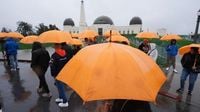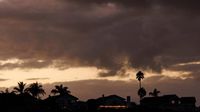As the sun finally broke through the dense cloud cover over Southern California on October 15, 2025, residents and officials surveyed a landscape transformed by a rare and potent October storm. The event, which struck on October 14, delivered a deluge of rain, fierce winds, and the kind of chaos that’s becoming all too familiar in a region still reeling from devastating wildfires earlier in the year.
For many in Pacific Palisades and nearby neighborhoods, the storm was more than just a weather event—it was a harsh reminder of the vulnerability that follows wildfire. As reported by AIR7 and corroborated by the Associated Press, dirty water and mud filled lots where homes once stood, burned to the ground by the massive January inferno that killed more than 30 people and destroyed over 17,000 homes and buildings in Los Angeles County.
“It looks like we’ve got about a foot and a half of water in the basement, so I didn’t realize it rained that much this morning,” said Louis Yannotti of Premiere Concrete, who had just begun work on a property destroyed by the January fire. The rain forced him to postpone construction yet again. General contractor Gregory Cemiceros echoed the frustration, telling AIR7 that despite evacuation and rainstorm warnings, there wasn’t much they could do to mitigate the storm’s impact.
The National Weather Service had issued flash flood warnings for several counties, sounding the alarm especially for areas where recent fires had stripped hillsides of vegetation. Without roots to hold the soil, the terrain became dangerously unstable. David Roth, a forecaster with the Weather Prediction Center in College Park, Maryland, explained to the Associated Press, “Fires make the soil become ‘an oil-like surface’ that is impermeable… The first year after a severe fire or a significant fire is the worst year, and just everything runs off. It’s almost like the ground has become asphalt.”
By Tuesday afternoon, most of the Los Angeles area had received up to 1.5 inches of rain, while the San Gabriel Mountains northeast of the city saw over 5 inches. The rainfall was a welcome sight for some, given Southern California’s prolonged drought—Curtis Riganti of the National Drought Mitigation Center told the Associated Press, “It’s definitely welcome rain… But how much it helps… it’s too soon to tell.”
But for others, the storm’s intensity brought only new dangers. Authorities ordered the evacuation of about 115 homes, mostly in Pacific Palisades and Mandeville Canyon—neighborhoods still scarred from January’s deadly fire. The Los Angeles Times and AccuWeather both reported that evacuation warnings were issued in burn scar areas, including the Palisades, Eaton, Hurst, and Sunset fires. The warnings remained in effect overnight, with officials warning of potential mudslides, debris flows, and road flooding.
Los Angeles Mayor Karen Bass addressed residents on the eve of the storm, emphasizing the city’s readiness: “We’re very concerned about the weather,” she said, adding that strike teams, rescue units, and helicopters were on standby. As the rain intensified, firefighters rescued two people and two dogs from the swollen Los Angeles River, with one man hospitalized for exposure. Roads became treacherous, with drivers hydroplaning and accidents mounting on flooded streets.
More than 21,000 customers across Southern and central California lost power, according to PowerOutage.us. The National Weather Service described the system as a “rare and very potent storm,” warning of high winds capable of knocking down trees and power lines. Tornado warnings were issued early on October 14, though by noon, none had materialized. The Storm Prediction Center noted that the threat for gusty winds and perhaps a brief tornado would gradually diminish through midday.
Sections of state Route 27, beginning at the Pacific Coast Highway, were closed in preparation for the storm, Caltrans announced. The Pacific Coast Highway itself was no stranger to the storm’s wrath; in February, torrential rains had already caused debris flows and mudslides in neighborhoods torched by the January fires, submerging parts of the highway in at least three feet of sludge and sweeping a Los Angeles Fire Department vehicle into the ocean.
As the storm raged, residents like Alex and Kateryna Tsykhanivski tried to make the best of it, venturing out to the Griffith Observatory despite the downpour. “It doesn’t rain much in LA. So every time we see rain, we like to go out,” Alex told the Associated Press. But for most, the advice from officials was clear: stay indoors and remain alert.
Further north, the Sierra Nevada braced for a different kind of storm. The Mammoth Mountain Ski Area reported snowfall Tuesday morning, with up to three feet predicted for higher elevations. AccuWeather senior meteorologist Alex Sosnowski warned that snow levels could drop to around 5,000 feet, causing travel delays on major routes like Interstate 80 through Donner Pass. “Travelers planning to drive… can expect a couple of inches of slushy snow and delays,” added Courtney Travis, another AccuWeather meteorologist.
Elsewhere in the country, the weather was no less dramatic. In Alaska, Typhoon Halong brought hurricane-force winds and floodwaters that swept away homes, leaving one dead and two missing in the state’s western reaches. Over 50 people had to be rescued, some from rooftops. In Tempe, Arizona, a microburst and thunderstorm dropped half an inch of rain in just 10 minutes, uprooting trees, tearing roofs off buildings, and leaving thousands without power. Colorado’s Pagosa Springs saw the San Juan River flood its banks, forcing about 100 residents from their homes and closing schools.
Back in Southern California, the worst of the storm had cleared by 1 p.m. on October 15, and evacuation orders were lifted by evening. Still, an evacuation warning remained in place for areas impacted by the Palisades Fire until 6 a.m. Wednesday. The National Weather Service forecasted a shift to dry conditions and a warming trend beginning Wednesday, offering a reprieve for weary residents and emergency crews alike.
The storm’s unpredictability was a recurring theme. Ariel Cohen, meteorologist in charge at the National Weather Service in Los Angeles, summed it up: “The nature of this system is such that we cannot be certain about exactly when and where these impacts will strike, the exact details until right before they occur at the earliest.”
For communities still recovering from January’s devastation, the October storm was both a test and a stark reminder of how quickly nature can change course. With the ground still behaving like asphalt and the threat of debris flows ever-present, the road to recovery remains long and uncertain. But as clear skies return, so too does the resolve to rebuild and prepare for whatever comes next.





